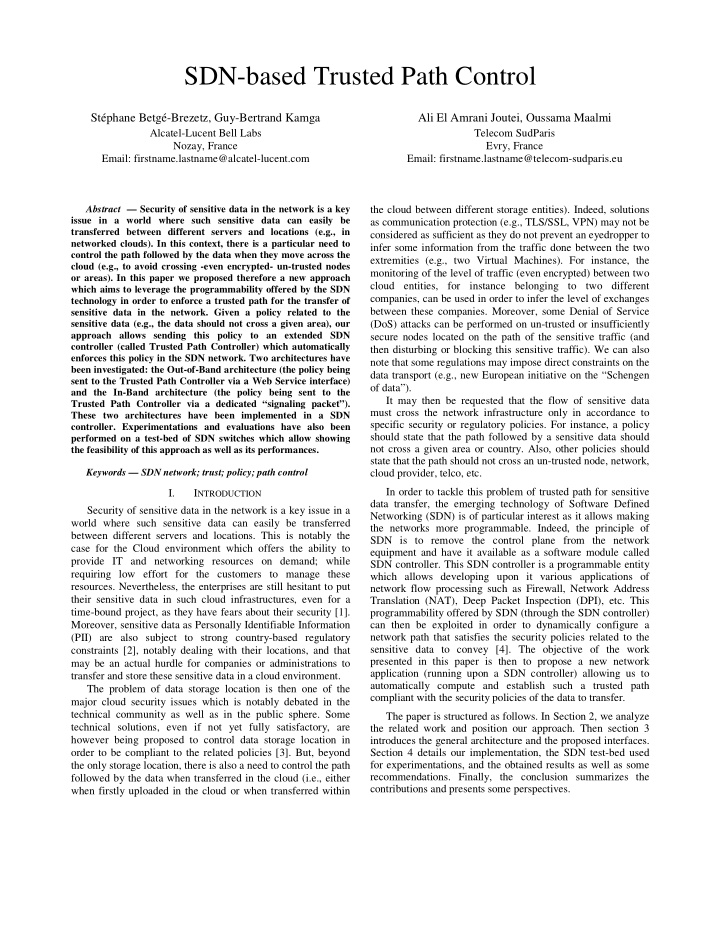



SDN-based Trusted Path Control Stéphane Betgé-Brezetz, Guy-Bertrand Kamga Ali El Amrani Joutei, Oussama Maalmi Alcatel-Lucent Bell Labs Telecom SudParis Nozay, France Evry, France Email: firstname.lastname@alcatel-lucent.com Email: firstname.lastname@telecom-sudparis.eu Abstract — Security of sensitive data in the network is a key the cloud between different storage entities). Indeed, solutions issue in a world where such sensitive data can easily be as communication protection (e.g., TLS/SSL, VPN) may not be transferred between different servers and locations (e.g., in considered as sufficient as they do not prevent an eyedropper to networked clouds). In this context, there is a particular need to infer some information from the traffic done between the two control the path followed by the data when they move across the extremities (e.g., two Virtual Machines). For instance, the cloud (e.g., to avoid crossing -even encrypted- un-trusted nodes monitoring of the level of traffic (even encrypted) between two or areas). In this paper we proposed therefore a new approach cloud entities, for instance belonging to two different which aims to leverage the programmability offered by the SDN companies, can be used in order to infer the level of exchanges technology in order to enforce a trusted path for the transfer of between these companies. Moreover, some Denial of Service sensitive data in the network. Given a policy related to the sensitive data (e.g., the data should not cross a given area), our (DoS) attacks can be performed on un-trusted or insufficiently approach allows sending this policy to an extended SDN secure nodes located on the path of the sensitive traffic (and controller (called Trusted Path Controller) which automatically then disturbing or blocking this sensitive traffic). We can also enforces this policy in the SDN network. Two architectures have note that some regulations may impose direct constraints on the been investigated: the Out-of-Band architecture (the policy being data transport (e.g., new European initiative on the “Schengen sent to the Trusted Path Controller via a Web Service interface) of data”). and the In-Band architecture (the policy being sent to the It may then be requested that the flow of sensitive data Trusted Path Controller via a dedicated “signaling packet”). must cross the network infrastructure only in accordance to These two architectures have been implemented in a SDN specific security or regulatory policies. For instance, a policy controller. Experimentations and evaluations have also been should state that the path followed by a sensitive data should performed on a test-bed of SDN switches which allow showing not cross a given area or country. Also, other policies should the feasibility of this approach as well as its performances. state that the path should not cross an un-trusted node, network, Keywords — SDN network; trust; policy; path control cloud provider, telco, etc. In order to tackle this problem of trusted path for sensitive I. I NTRODUCTION data transfer, the emerging technology of Software Defined Security of sensitive data in the network is a key issue in a Networking (SDN) is of particular interest as it allows making world where such sensitive data can easily be transferred the networks more programmable. Indeed, the principle of between different servers and locations. This is notably the SDN is to remove the control plane from the network case for the Cloud environment which offers the ability to equipment and have it available as a software module called provide IT and networking resources on demand; while SDN controller. This SDN controller is a programmable entity requiring low effort for the customers to manage these which allows developing upon it various applications of resources. Nevertheless, the enterprises are still hesitant to put network flow processing such as Firewall, Network Address their sensitive data in such cloud infrastructures, even for a Translation (NAT), Deep Packet Inspection (DPI), etc. This time-bound project, as they have fears about their security [1]. programmability offered by SDN (through the SDN controller) Moreover, sensitive data as Personally Identifiable Information can then be exploited in order to dynamically configure a network path that satisfies the security policies related to the (PII) are also subject to strong country-based regulatory sensitive data to convey [4]. The objective of the work constraints [2], notably dealing with their locations, and that presented in this paper is then to propose a new network may be an actual hurdle for companies or administrations to application (running upon a SDN controller) allowing us to transfer and store these sensitive data in a cloud environment. automatically compute and establish such a trusted path The problem of data storage location is then one of the compliant with the security policies of the data to transfer. major cloud security issues which is notably debated in the technical community as well as in the public sphere. Some The paper is structured as follows. In Section 2, we analyze technical solutions, even if not yet fully satisfactory, are the related work and position our approach. Then section 3 however being proposed to control data storage location in introduces the general architecture and the proposed interfaces. order to be compliant to the related policies [3]. But, beyond Section 4 details our implementation, the SDN test-bed used for experimentations, and the obtained results as well as some the only storage location, there is also a need to control the path recommendations. Finally, the conclusion summarizes the followed by the data when transferred in the cloud (i.e., either contributions and presents some perspectives. when firstly uploaded in the cloud or when transferred within
Recommend
More recommend